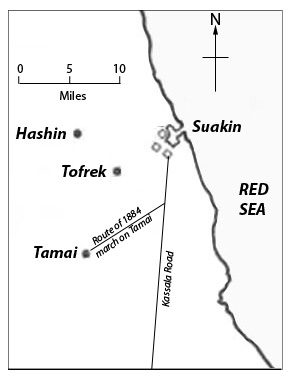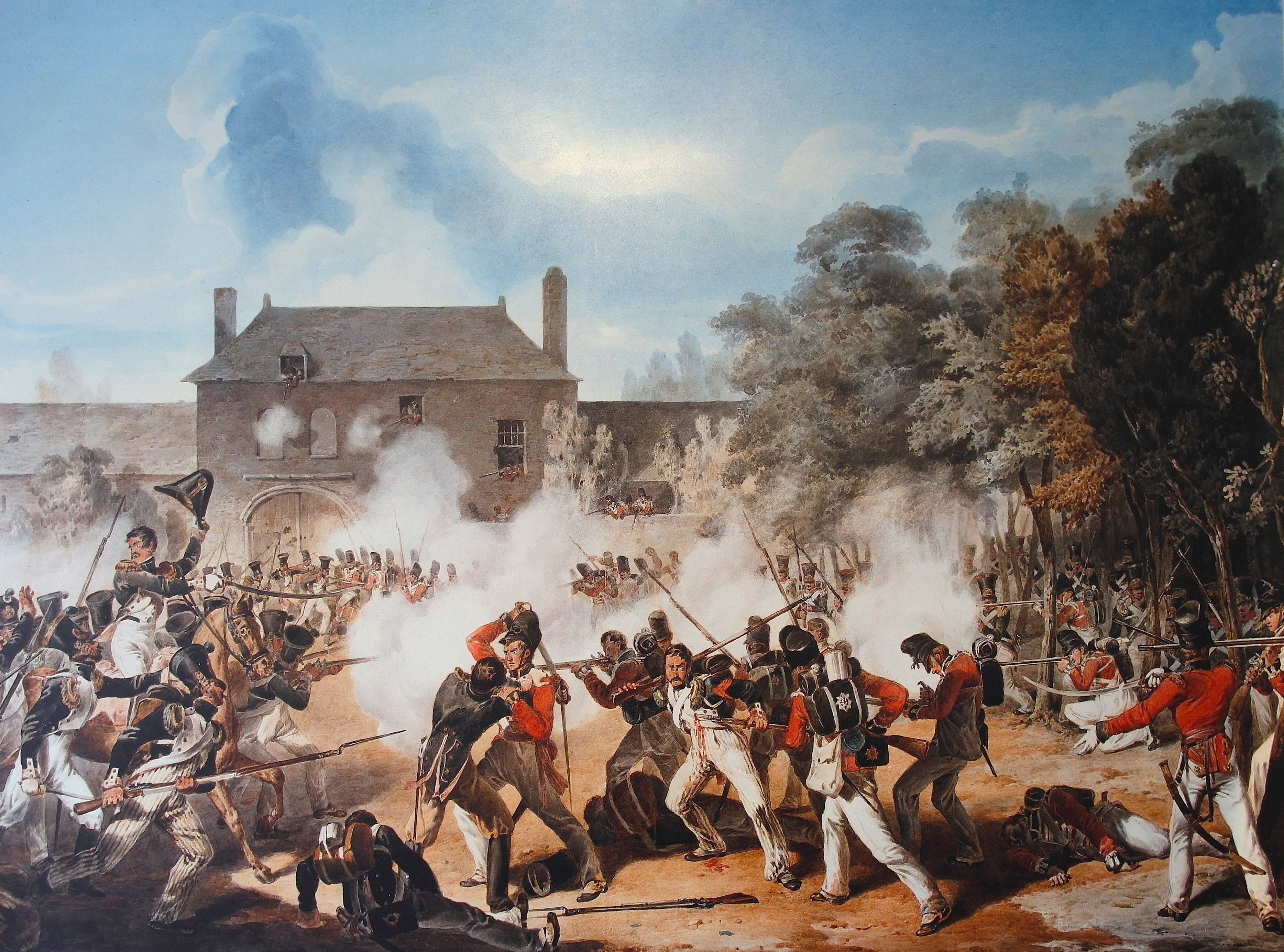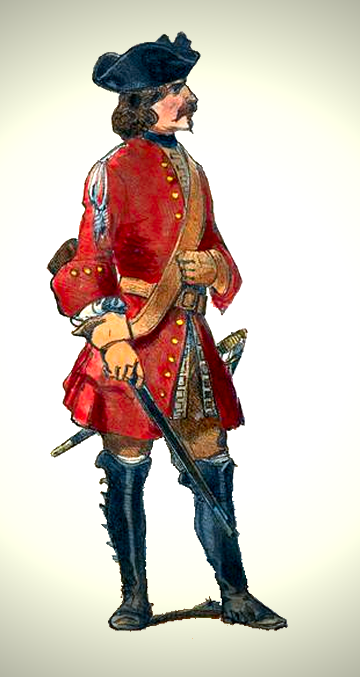|
Battle Of Tofrek
The Battle of Tofrek was fought on 22 March 1885 some 5 miles inland from the port of Suakin on the Red Sea coast of Sudan. A contingent of some 3000 troops from the British and Indian "Suakin Field Force" led by Major General Sir John Carstairs McNeill VC, GCVO, KCB, KCMG (under the overall command of General Gerald Graham) was attacked by a Mahdist force under the leadership of Osman Digna. The Mahdists were heavily defeated, losing some 1000 of their 2000 fighters as compared to the loss of 70 British and Indian soldiers plus over 100 casualties. Background The sacking of Khartoum and the killing of General Gordon and the massacre of thousands of civilians at the hands of Mahdist warriors in January 1885, together with the failure of the relief effort of General Wolseley's Nile Expedition, prompted the British government to revive plans to build a railway between the port of Suakin on the Red Sea and Berber on the River Nile some 300 miles north of Khartoum, to provide ... [...More Info...] [...Related Items...] OR: [Wikipedia] [Google] [Baidu] |
Mahdist War
The Mahdist War ( ar, الثورة المهدية, ath-Thawra al-Mahdiyya; 1881–1899) was a war between the Mahdist Sudanese of the religious leader Muhammad Ahmad bin Abd Allah, who had proclaimed himself the "Mahdi" of Islam (the "Guided One"), and the forces of the Khedivate of Egypt, initially, and later the forces of Britain. Eighteen years of war resulted in the nominally joint-rule state of the Anglo-Egyptian Sudan (1899–1956), a ''de jure'' condominium of the British Empire and the Kingdom of Egypt in which Britain had ''de facto'' control over the Sudan. The Sudanese launched several unsuccessful invasions of their neighbours, expanding the scale of the conflict to include not only Britain and Egypt but also the Italian Empire, the Congo Free State and the Ethiopian Empire. The British participation in the war is called the Sudan campaign. Other names for this war include the Mahdist Revolt, the Anglo–Sudan War and the Sudanese Mahdist Revolt. Background Followi ... [...More Info...] [...Related Items...] OR: [Wikipedia] [Google] [Baidu] |
Edward Pemberton Leach
General Sir Edward Pemberton Leach (2 April 1847 – 27 April 1913) was an Irish recipient of the Victoria Cross, the highest and most prestigious award for gallantry in the face of the enemy that can be awarded to British and Commonwealth forces. Early life Leach was born in County Londonderry, Ireland on 2 April 1847. He was educated at Highgate School in England. Military career Leach was commissioned into the Royal Engineers in 1866.Royal Engineers Museum He was 31 years old, and a captain in the , |
15th Ludhiana Sikhs
The 15th Ludhiana Sikhs was an infantry regiment in the British Indian Army. They could trace their origins to 1846, when they were known as the Regiment of Ludhiana (or the Loodiana Regiment). During the Indian Mutiny they were relied upon to hold Benares throughout the period of the Mutiny. In 1861, they became the 15th Bengal Native Infantry and shortly afterwards to the 15th (Ludhiana) Regiment of Bengal Native Infantry in 1864. Further changes in title followed they became the 15th Regiment of Bengal Native Infantry (Ludhiana Sikhs) in 1885, the 15th (Ludhiana) Sikh Infantry in 1901 and the 15th Ludhiana Sikhs following the Kitchener reforms of the Indian Army in 1903. To honour the visit of the Prince and Princess of Wales to Indian they took part in the Rawalpindi Parade 1905. During this time they took part in the Battle of Ahmed Khel and the Battle of Kandahar in the Second Anglo-Afghan War. They then took part in the Battle of Tofrek and Suakin in the Mahdist War, the ... [...More Info...] [...Related Items...] OR: [Wikipedia] [Google] [Baidu] |
17th Infantry (The Loyal Regiment)
The 17th Infantry (The Loyal Regiment) was an infantry regiment of the Bengal Army, later of the united British Indian Army. It was formed at Phillour in 1858 by Major J. C. Innes from men of the 3rd, 36th and 61st Bengal Native Infantry regiments who remained loyal to the British East India Company during the Indian Mutiny, and designated ''The Loyal Purbiah Regiment''.''Quarterly Indian Army List January'' 1919, p. 1086 It was subsequently re-designated as follows:- *17th Regiment of Bengal Native Infantry – 1861 *17th (The Loyal Purbiah) Regiment of Bengal Native Infantry – 1864 *17th (The Loyal Purbiah) Regiment of Bengal Infantry –1885 *17th (The Loyal Regiment) of Bengal Infantry – 1898 *17th Musalman Rajput Infantry (The Loyal Regiment) – 1902 Its final designation came in 1903 with the Kitchener reforms of the Indian Army. The regiment took part in the Second Anglo-Afghan War, the Battle of Tofrek the siege of Suakin in the Sudan Campaign and World War I. Duri ... [...More Info...] [...Related Items...] OR: [Wikipedia] [Google] [Baidu] |
Scots Guards
The Scots Guards (SG) is one of the five Foot Guards regiments of the British Army. Its origins are as the personal bodyguard of King Charles I of England and Scotland. Its lineage can be traced back to 1642, although it was only placed on the English Establishment (thus becoming part of what is now the British Army) in 1686. History Formation; 17th century The regiment now known as the Scots Guards traces its origins to the Marquis of Argyll's Royal Regiment, a unit raised in 1642 by Archibald Campbell, 1st Marquess of Argyll in response to the 1641 Irish Rebellion. After the Restoration of Charles II, the Earl of Linlithgow received a commission dated 23 November 1660 to raise a regiment which was called The Scottish Regiment of Footguards. It served in the 1679 Covenanter rising of 1679, as well as Argyll's Rising in June 1685, after which it was expanded to two battalions. When the Nine Years War began in 1689, the first battalion was sent to Flanders; the second served ... [...More Info...] [...Related Items...] OR: [Wikipedia] [Google] [Baidu] |
Coldstream Guards
The Coldstream Guards is the oldest continuously serving regular regiment in the British Army. As part of the Household Division, one of its principal roles is the protection of the monarchy; due to this, it often participates in state ceremonial occasions. The Regiment has consistently provided formations on deployments around the world and has fought in the majority of the major conflicts in which the British Army has been engaged. The Regiment has been in continuous service and has never been amalgamated. It was formed in 1650 as 'Monck's Regiment of Foot' and was then renamed 'The Lord General's Regiment of Foot Guards' after the restoration in 1660. With Monck's death in 1670 it was again renamed 'The Coldstream Regiment of Foot Guards' after the location in Scotland from which it marched to help restore the monarchy in 1660. Its name was again changed to 'The Coldstream Guards' in 1855 and this is still its present title. Today, the Regiment consists of: Regimental Headq ... [...More Info...] [...Related Items...] OR: [Wikipedia] [Google] [Baidu] |
Grenadier Guards
"Shamed be whoever thinks ill of it." , colors = , colors_label = , march = Slow: " Scipio" , mascot = , equipment = , equipment_label = , battles = Oudenarde WaterlooAlmaInkermanSevastopol OmdurmanYpresBattle of the BulgeCyprus Emergency , anniversaries = , decorations = , battle_honours = , battle_honours_label = , disbanded = , flying_hours = , website = , commander1 = The King , commander1_label = Colonel-in-Chief , commander2 = The Queen Consort , commander2_label = Colonel of the Regiment , commander3 = , commander3_label = , commander4 = , commander4_label ... [...More Info...] [...Related Items...] OR: [Wikipedia] [Google] [Baidu] |
Royal Horse Artillery
The Royal Horse Artillery (RHA) was formed in 1793 as a distinct arm of the Royal Regiment of Artillery (commonly termed Royal Artillery) to provide horse artillery support to the cavalry units of the British Army. (Although the cavalry link remained part of its defining character, as early as the Battle of Waterloo the RHA was sometimes deployed more along the lines of conventional field artillery, fighting from comparatively fixed positions). The Royal Horse Artillery, currently consists of three regiments, ( 1 RHA, 3 RHA and 7 RHA) and one ceremonial unit (King's Troop, Royal Horse Artillery). Almost all the batteries of the Royal Horse Artillery have served continuously since the French Revolutionary Wars or Napoleonic Wars, except the King's Troop, created in 1946, and M Battery which was 'reanimated' in 1993. Horses are still in service for ceremonial purposes but were phased out from operational deployment in the 1930s. History In 1793, in the course of the French ... [...More Info...] [...Related Items...] OR: [Wikipedia] [Google] [Baidu] |
Mounted Infantry
Mounted infantry were infantry who rode horses instead of marching. The original dragoons were essentially mounted infantry. According to the 1911 ''Encyclopædia Britannica'', "Mounted rifles are half cavalry, mounted infantry merely specially mobile infantry." Today, with motor vehicles having replaced horses for military transport, the motorized infantry are in some respects successors to mounted infantry. History Pre-gunpowder The origins of mounted infantry go back to at least the beginnings of organised warfare. With the weight of ancient bronze armor, the opposing champions would travel to battle on chariots before dismounting to fight. With the evolution of hoplite warfare, some hoplites would travel to battle on horseback, before dismounting to take their place in the phalanx. The early pre-Marian Roman military had units consisting of infantrymen clinging to the saddles of the cavalry to take them to battle and then dismounting to fight. Gallic and Germanic warban ... [...More Info...] [...Related Items...] OR: [Wikipedia] [Google] [Baidu] |
20th Hussars
The 20th Hussars was a cavalry regiment of the British Army. After service in the First World War it was amalgamated with the 14th King's Hussars to form became the 14th/20th King's Hussars in 1922. History Early wars The regiment was originally raised in Bengal by the East India Company as the 2nd Bengal European Light Cavalry in 1858, for service in the response to the Indian Rebellion. It was renamed the 2nd Bengal European Cavalry in 1859 and in 1862, while based in Mathura, it was transferred to the British Army and renamed the 20th Regiment of Hussars. It became the 20th Hussars in 1877. The regiment remained on the North West Frontier and participated in the Ambela Campaign in autumn 1863 and the Hazara Expedition in October 1868 before moving to England in 1872. The regiment was based in Ireland from 1879 to 1884. The regiment was sent to Sudan as part of the Suakin Expedition in February 1885 and took part in the Battle of Tofrek in March 1885 and the Battle of Ginnis ... [...More Info...] [...Related Items...] OR: [Wikipedia] [Google] [Baidu] |
5th Royal Irish Lancers
The 5th Royal Irish Lancers was a cavalry regiment of the British Army. It saw service for three centuries, including the First World War. It amalgamated with the 16th The Queen's Lancers to become the 16th/5th Lancers in 1922. History Early wars The regiment was originally formed in 1689 by Brigadier James Wynne as James Wynne's Regiment of Dragoons. It fought at the Battle of the Boyne in July 1690 and at the Battle of Aughrim later that month under King William III. Renamed the Royal Dragoons of Ireland in 1704, it went on to fight under the Duke of Marlborough at the Battle of Blenheim in August 1704 during the War of the Spanish Succession. At the Battle of Ramillies in May 1706 the regiment helped capture the entire French "Regiment du Roi", after which it fought at the Battle of Oudenarde in July 1708 and at the Battle of Malplaquet in September 1709. In 1751, it was retitled 5th Regiment of Dragoons and in 1756 it became the 5th (or Royal Irish) Regiment of Dragoons. A ... [...More Info...] [...Related Items...] OR: [Wikipedia] [Google] [Baidu] |
Madras Engineer Group
Madras Engineer Group (MEG), informally known as the Madras Sappers, is an engineer group of the Corps of Engineers of the Indian Army. The Madras Sappers draw their origin from the erstwhile Madras Presidency army of the British Raj. This regiment has its HQ in Bengaluru. The Madras Sappers are the oldest of the three groups of the Corps of Engineers. The Madras Sappers were the only regiment of the Madras Presidency Army to survive unscathed the extensive reorganisations that took place between 1862 and 1928. The ''thambis'', as the troops of the Madras Sappers are popularly known, with their hallmark Shakos have distinguished themselves in many battlefields around the world for more than 200 years. The Bangalore torpedo, a mine clearing explosive device, was invented in the Centre at Bengaluru in the early years of the Twentieth Century. Timeline * 1780 – Created ''Madras Pioneers'' from two company of Pioneers (On 30 September 1780 at Madras Patnam) * 1831 – Rena ... [...More Info...] [...Related Items...] OR: [Wikipedia] [Google] [Baidu] |


_Sikh_Regiment_in_China%2C_Circa_1860..jpg)





_p012_Bugler_Sherlock.jpg)